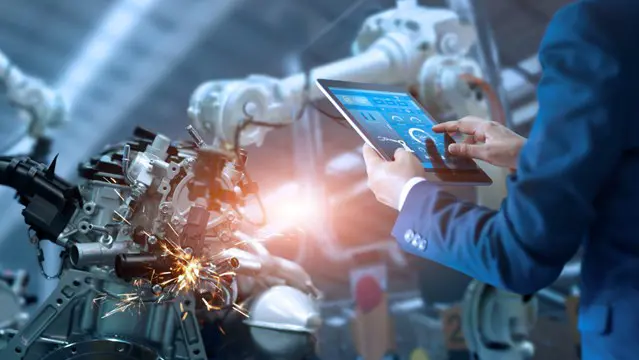
The Full Stack Data Scientist BootCamp®
Stats,Python| SQL| Machine Learning&Cloud| Deep Learning| A.I | Computer Vision & NLP| Power BI | Internships & Jobs
Total Data Science
Summary
- Certificate of completion - Free
- Reed Courses Certificate of Completion - Free
- Tutor is available to students
Add to basket or enquire
Overview
By far the most comprehensive, up-to-date, and most credible Data Science course on Data Science. The Full-Stack Data Scientist BootCamp® is the all-in-one course that covers A to Z of lessons that will make you a Data Scientist.
Created by Dr. Bright, a Ph.D. in Data Science holder, former Microsoft Senior Data Scientist, and a Visiting Faculty at Worcester Institute, this course covers everything that you need to know to become a Full Stack Data Scientist.
The instructors and advisors of the course spent over 13 months creating and vetting the course to make sure it meets the industry and academic standards.
With over 100 hours of quality course curriculum, this course is the same as we use for our 18 months MS in Data Science program on campus and even more exciting are the Projects in the course to make you more efficient and confident in building Data Science and Artificial Intelligence (AI) products.
The motivation is to bring Quality Data Science education to every serious learner at affordable cost. Everyone who cannot to spend $30,000 plus on attaining a data science degree at a top tier institute or anyone who cannot spend considerable amount of time on campus away from their busy schedule.
This course is meant for students and working professionals who wish to become Data scientists, Machine Learning Engineers, and AI professionals.
Curriculum
-
WEEK 1 :: DATA SCIENCE OVERVIEW 2:09:19
-
COMPLETE SQL FOR DATA SCIENCE COURSE 01:00
-
SQL : BEGINNER LEVEL 44:48
-
SQL COMMANDS 04:18
-
UNDERSTANDING AND CREATING SQL DATABASES 06:50
-
UNDERSTANDING AND CREATING SQL TABLES 03:14
-
TYPES OF SQL KEYS 11:53
-
DATA TYPES IN SQL 07:38
-
CREATE TABLE AND INSERT DATA INTO TABLE 19:36
-
SQL CONSTRAINTS 42:19
-
WEEK 2 :: SQL INTERMEDIATE LEVEL 2:18:05
-
SQL JOINS 1:11:14
-
WORKING WITH EXISTING SQL TABLE 24:45
-
SQL VIEW 17:29
-
SQL DATA SUMMARIZATION: AGGREGATION FUNCTIONS 08:25
-
ADVANCE SQL FUNCTIONS 39:15
-
WEEK 3 :: SQL ADVANCED LEVEL 01:00
-
SQL STORED PROCEDURE 21:43
-
TRIGGERS 25:24
-
TRANSACTION 17:07
-
RECOMMENDATION 01:00
-
FULL PYTHON FOR DATA SCIENCE COURSE 53:51
-
Datasets 01:00
-
Hands-On With Python 42:09
-
PYTHON OUTPUT(), INPUT() AND IMPORT() FUNCTIONS 15:17
-
PYTHON OPERATORS 27:59
-
PYTHON FLOW CONTROL 28:20
-
WEEK 2: PYTHON FUNCTIONS 35:34
-
PYTHON GLOBAL AND LOCAL VARIABLES 06:26
-
WORKING WITH FILES IN PYTHON 19:09
-
PYTHON MODULES 10:00
-
PYTHON PACKAGES AND LIBRARIES 11:29
-
DATA TYPES IN PYTHON 27:29
-
EXTRA CONTENT 43:00
-
WEEK 3: NUMPY 1:21:31
-
Numpy assignment 01:00
-
WEEK 4: PANDAS 2:35:39
-
DATA VISUALISATION: MATPLOTIIB AND SEABORN 1:42:52
-
PROJECT: PYTHON ASSIGNMENT 01:00
-
PYTHON PROJECTS 2:42:15
-
2ND MONTH 01:00
-
FULL STATISTICS FOR DATA SCIENCE 13:39
-
STATISTICAL METHODS DEEP DIVE 15:28
-
Data 18:38
-
FREQUENCY DISTRIBUTION 15:02
-
CENTRAL TENDENCY 18:58
-
MEASURES OF DISPERSION 12:00
-
COEFFICIENT OF VARIATIONS 05:46
-
THE FIVE NUMBER SUMMARY & THE QUARTILES 14:27
-
THE NORMAL DISTRIBUTION 28:44
-
CORRELATION 14:51
-
3RD MONTH 01:00
-
WEEK 1 :: PROBABILITY 39:59
-
BAYE'S THEOREM 01:06
-
HYPOTHESIS TESTING 26:18
-
Stats Project 02:00
-
GITHUB FOR DATA SCIENCE 49:15
-
ARTIFICIAL INTELLIGENCE(AI) AND MACHINE LEARNING(ML) 01:00
-
WEEK 2 :: FULL MACHINE LEARNING COURSE 57:00
-
USE CASE 24:47
-
MACHINE LEARNING ALGORITHMS 29:05
-
WORKING WITH MACHINE LEARNING DATA 1:13:57
-
WEEK 3 :: SUPERVISED MACHINE LEARNING ALGORITHMS 45:32
-
LAB SESSION: LINEAR REGRESSION 2:12:01
-
LOGISTIC REGRESSION ALGORITHM 2:32:39
-
NAIVE BAYES ALGORITHM 1:10:42
-
K-NEAREST NEIGBHOR ALGORITHM (KNN) 1:36:10
-
SUPPORT VECTOR MACHINE (SVM) ALGORITHM 1:06:28
-
MACHINE LEARNING ALGORITHM PERFORMANCE METRICS 1:12:51
-
DECISION TREE ALGORITHM 1:08:31
-
WEEK 4 :: ENSEMBLE TECHNIQUES 4:31:04
-
OVERFITTING AND UNDERFITTING 1:39:34
-
BIAS VS VARIANCE 52:27
-
PROJECT: SUPERVISED MACHINE LEARNING 02:00
-
4TH MONTH 01:00
-
UNSUPERVISED MACHINE LEARNING ALGORITHMS 01:00
-
WEEK 3: K-MEANS CLUSTERING ALGORITHM 1:21:04
-
HIERARCHICAL CLUSTERING ALGORITHM 1:20:50
-
PRINCIPAL COMPONENT ANALYSIS (PCA) 37:45
-
PROJECT: UNSUPERVISED MACHINE LEARNING 03:00
-
FEATURE ENGINEERING : MODEL SELECTION & OPTIMIZATION 2:38:17
-
WEEK 2 :: ADVANCED FEATURE ENGINEERING 01:00
-
SAVING AND LOADING ML MODEL 01:00
-
Web Scraping On Wikipedia 08:12
-
PROJECT: WIKIPEDIA WEB SCRAPING 31:58
-
PROJECT: ONLINE BOOK STORE WEB SCRAPPING 55:36
-
WEB SCRAPING: BUILDING AMAZON AUTO SCRAPER 44:30
-
WEEK 4 :: RECOMMENDATION SYSTEMS 2:08:56
-
4TH MONTH 01:00
-
HANDS-ON PROJECTS 01:00
-
BANK NOTE ANALYSIS 2:07:24
-
BIG MART SALES PREDICTION 1:51:41
-
AMAZON.COM EMPLOYEE ACCESS CHALLENGE 1:17:28
-
BREAST CANCER DETECTION USING SVM AND KNN : PART 1 1:36:18
-
PREDICTING COMPRESSIVE STRENGTH OF CONCRETE 1:59:54
-
STOCK MARKET CLUSTERING 54:49
-
5TH MONTH 01:00
-
CLOUD DEPLOYMENT 01:00
-
STREAMLIT FOR BUILDING MACHINE LEARNING APPS 4:38:04
-
FLASK TUTORIAL 52:51
-
WEEK 1 ::END-TO-END MACHINE LEARNING WITH DEPLOYMENT : PREDICT RESTAURANT RATING 2:30:32
-
CLOUD :: HEROKU MACHINE LEARNING CLOUD DEPLOYMENT 1:59:40
-
CLOUD :: AMAZON WEB SERVICE (AWS) DEPLOYMENT 35:21
-
CLOUD :: MICROSOFT AZURE DEPLOYMENT 23:09
-
WEEK 2 :: PROJECTS SESSION: MACHINE LEARNING 01:00
-
ML PROJECTS: BUILDING A NETFLIX RECOMMENDATION SYSTEM 2:48:40
-
5TH MONTH 01:00
-
ML PROJECTS: BUILDING CRUD APP 33:30
-
ML PROJECT: BUILDING COVID-19 REPORT DASHBOARD FOR BERLIN CITY 46:26
-
ML PROJECTS: BUILDING IPL SCORE PREDICTOR APP 1:01:05
-
ML PROJECTS: BUILDING A SALES FORCAST APP 1:26:44
-
WEEK 1 :: DEEP LEARNING 50:11
-
ARTIFICIAL NEURAL NETWORK 1:22:07
-
WEEK 2 :: ACTIVATION FUNCTIONS 1:04:44
-
TENSORFLOW AND KERAS 18:45
-
LAB SESSION: DEEP LEARNING(ANN) 2:35:06
-
WEEK 3 :: FULL COMPUTER VISION COURSE 01:00
-
COMPUTER VISION (CV): BEGINNER LEVEL 52:12
-
CPU VS GPU VS TPU 21:56
-
COMPUTER VISION: INTERMEDIATE LEVEL 2:58:16
-
WEEK 4 :: COMPUTER VISION: ADVANCED LEVEL 02:00
-
CNN ARCHITECTURES 1:30:55
-
TRANSFER LEARNING 41:53
-
OBJECT DETECTION 24:22
-
PERFORMANCE METRICS FOR OBJECT DETECTION 14:27
-
OBJECTION DETECTION TECHNIQUES 2:15:43
-
7TH MONTH 01:00
-
WEEK 1 :: OPENCV FULL TUTORIAL 2:12:18
-
CV PROJECT: CAR PARKING SPACE COUNTER USING OPENCV 1:35:18
-
CV PROJECT(KAGGLE): FRUIT AND VEGETABLE CLASSIFICATION 1:22:37
-
CV PROJECT: PREDICTING LUNG DISEASE WITH COMPUTER VISION 26:26
-
WEEK 2 :: CV PROJECT: NOSE MASK DETECTION WITH COMPUTER VISION 30:30
-
CV PROJECT: POSE DETECTION 28:13
-
CV PROJECT: BUILDING A VIRTUAL AI KEYBOARD 1:09:25
-
CV PROJECT: YOLOV4 OBJECT DETECTION USING WEBCAM 28:19
-
WEEK 3 :: NATURAL LANGUAGE PROCESSING(NLP) 30:40
-
What Next? 01:00
Course media
Description
Beginner To Advanced Level
Complete In 9 Months or Less !!
This course is meant for students and working professionals who wish to become Data scientists, Machine Learning Engineers, and AI professionals.
The ALL IN ONE Course !
All of the following are included in the Course:
- Full SQL Course from A-Z
- Full Python Course from A-Z
- Full Statistics for Data Science course from A-Z
- Full Machine Learning course from A-Z
- Full ML Model Cloud Deployment course A-Z
- Full Deep Learning course from A-Z
- Full Artificial Intelligence course from A-Z
- Full Computer Vision course from A-Z
- Full Natural Language Processing course from A-Z
- Full Microsoft Power BI course from A-Z
- Reading Scientific Research Paper
- Github for Data Science
- Recommendation System
- A guide to do Virtual Internship
Who is this course for?
This course is for:
- Students who wish to work as Data Scientist
- Working professionals who want to transition to the field of Artificial Intelligence(A.I.) , Machine Learning, Deep learning, Computer Vision(CV), Natural Language Processing(NLP)
- Anyone interested in building A.I applications such as ChatGPT or BARD
- Anyone interesting in diving deeper into the field of Computer Vision(CV), Natural Language Processing(NLP)
- Anyone aspiring to be a Computer Vision(CV) or Natural Language Processing(NLP) engineer.
- Anyone finding it difficult to understand the field and concepts in Data Science and wants a breakdown step-by-step guide in understanding these concepts.
- Anyone who wants to be career secured and not easily affected by layoffs in organizations
- Anyone looking for salary hikes and increase in salary with a lucrative tech career.
Requirements
This is a beginner to advanced course and the instructor with many years of experience in the industry and classroom breaks the concepts down for anyone at any level to understand.
A laptop, internet connections and willingness to learn is enough to succeed in this comprehensive course.
Career path
Students in this course can choose a career path to become:
- Data Scientist
- Computer Vision(CV) engineer,
- Natural Language Processing(NLP) engineer
- Data Analyst
- Data consultant
- Pursue high degree : masters or PhD in the field or Data Science, Analytics, Artificial intelligence
These careers are thoroughly discussed in the course so students can make informed decisions.
Questions and answers
Currently there are no Q&As for this course. Be the first to ask a question.
Certificates
Certificate of completion
Digital certificate - Included
Certificate will be issued via email once the course is completed.
Reed Courses Certificate of Completion
Digital certificate - Included
Will be downloadable when all lectures have been completed.
Reviews
Currently there are no reviews for this course. Be the first to leave a review.
Legal information
This course is advertised on reed.co.uk by the Course Provider, whose terms and conditions apply. Purchases are made directly from the Course Provider, and as such, content and materials are supplied by the Course Provider directly. Reed is acting as agent and not reseller in relation to this course. Reed's only responsibility is to facilitate your payment for the course. It is your responsibility to review and agree to the Course Provider's terms and conditions and satisfy yourself as to the suitability of the course you intend to purchase. Reed will not have any responsibility for the content of the course and/or associated materials.


